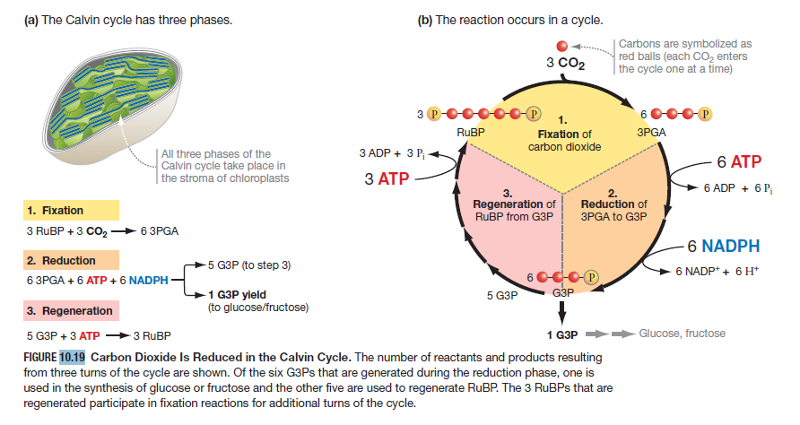What are the overall inputs (substrates and energy sources) and outputs (products and by- products) for the light-capturing reactions of photosynthesis and the Calvin cycle reactions of photosynthesis?

- Inputs: Light Energy ,Water, NADP^+,ADP
- Outputs: ATP, NADPH, O2
Calvin:
- Inputs:ATP, NADPH,CO2, RuBP
- Outputs: G3P
How are the light-capturing and Calvin cycle parts of photosynthesis coupled? How would poisoning the electron transport system associated with the light-capturing reactions of photosynthesis affect the Calvin cycle reactions?
The two reactions are linked by electrons that are released when water is split to form oxygen gas.
ATP and NADPH made from photosystem I used to reduce 3PGA to G3P. Would not have these molecules to make reduction and regeneration possible in cycle.
Where do the reactions of the light-capturing part of photosynthesis take place? Where do the reactions of the Calvin cycle reactions take place?
Both reactions take place in chloroplasts.
Light-capturing reactions: thylakoids
Calvin cycle: stroma
In what way are the structures of mitochondria and chloroplasts similar and different? What molecules or systems function in both types of organelles? Which enzymes or processes are unique to each organelle?
Both:
- Are circular in shape and have 2 membranes
- Are involved with ATP production via a proton gradient
- Have ATP synthases
- Have Electron Transport Chains
- Mitochondria: on the cristae
- Chloroplasts: on the thylakoid membrane
- Have their own ribosomes and DNA
Mitochondria:
- Smaller
- Generate ATP from glucose
- Found in plants, animals, or unicellular organisms
- Use the process of glycolysis
- ETC - electron potential energy starts high then steadily drops as the electrons are transferred to the terminal electron acceptor, which has the lowest potential energy
- Break down large molecules into energy
Chloroplasts:
- Bigger
- Generate ATP from sunlight
- Only found in plant cells
- Starch grains found in stroma
- Use the process of photosynthesis
- ETC - the reduced terminal electron acceptor (NADPH) has the higher potential energy than the electron donor (H2O)
- Carry rubisco
- Build up molecules from things like H2O and light
Give an example of two types of plant cells that lack chloroplasts. How do plant cells that lack chloroplasts produce the ATP they need? Do plant cells that contain chloroplasts also contain mitochondria?
Gamete sex cells? Roots, bulbs (underground so not exposed to light = no chloroplasts)
Plants that lack chloroplasts receive sugars but still need mitochondria to break up those sugars into ATP. Plant cells that contain chloroplasts more than likely also contain mitochondria.
Which has more chemical energy, 5 molecules of G3P or 3 molecules of RuBP? Explain.

RuBP have more chemical energy than 5 molecules of G3P. These 3 RuBP’s that are regenerated then participate in fixation reactions forming a cycle.